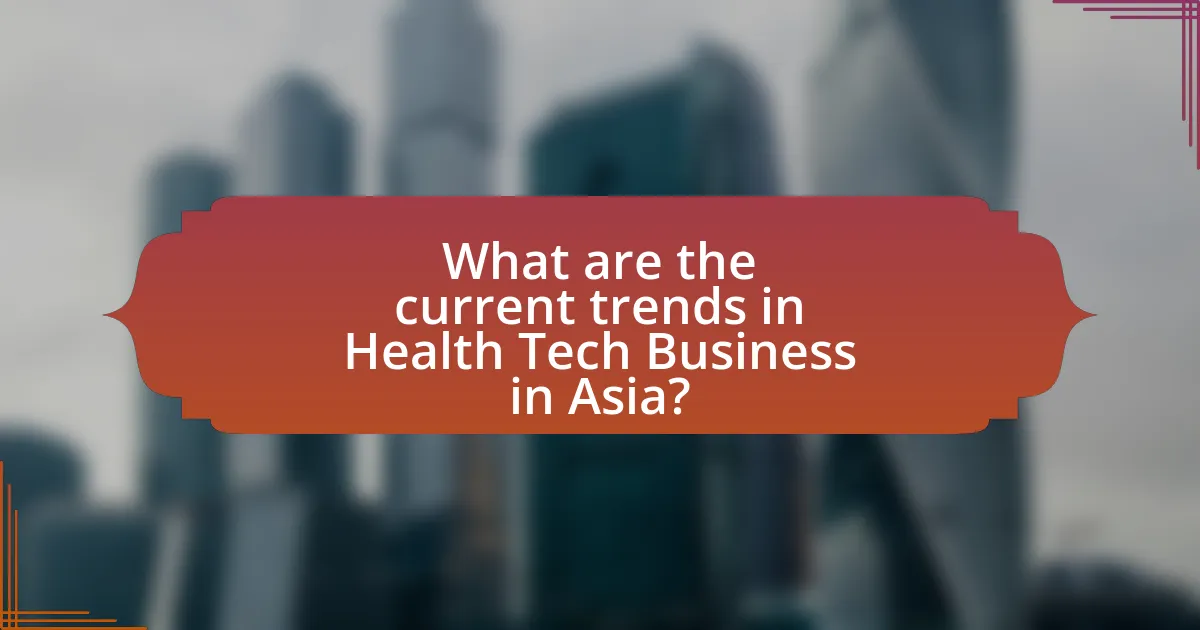The article examines the intersection of health technology and business in Asia, highlighting the rapid growth and innovation within the health tech sector. It discusses the significant market potential, projected to reach $200 billion by 2025, driven by increasing demand for digital health solutions, telemedicine, and AI applications. Key components such as telemedicine, electronic health records, and mobile health applications are analyzed, along with the varying adoption rates across different Asian countries. The article also addresses the challenges faced by health tech companies, including regulatory hurdles and data privacy concerns, while emphasizing the importance of partnerships and emerging technologies in driving future growth and improving healthcare accessibility in the region.

What is the Intersection of Health Tech and Business in Asia?
The intersection of health tech and business in Asia is characterized by rapid innovation and investment aimed at improving healthcare delivery and accessibility. In recent years, Asia has seen significant growth in health tech startups, driven by increasing demand for digital health solutions, telemedicine, and wearable health devices. For instance, the Asia-Pacific health tech market is projected to reach $200 billion by 2025, reflecting a compound annual growth rate of over 25%. This growth is supported by government initiatives promoting digital health, such as Singapore’s Smart Nation program and China’s Healthy China 2030 plan, which aim to integrate technology into healthcare systems. Additionally, partnerships between tech companies and healthcare providers are fostering the development of AI-driven diagnostics and personalized medicine, further solidifying the business potential within the health tech sector in Asia.
How is health technology defined in the context of business?
Health technology in the context of business is defined as the application of technology to improve healthcare delivery, enhance patient outcomes, and streamline operations within healthcare organizations. This includes innovations such as telemedicine, electronic health records, and health information systems, which facilitate efficient management of patient data and care processes. The World Health Organization emphasizes that health technology can significantly reduce costs and improve access to care, demonstrating its critical role in transforming healthcare systems and driving business growth in the health sector.
What are the key components of health technology in Asia?
The key components of health technology in Asia include telemedicine, electronic health records (EHR), mobile health applications, and health information systems. Telemedicine facilitates remote consultations, improving access to healthcare in rural areas; for instance, countries like India and China have implemented extensive telehealth services to reach underserved populations. Electronic health records enhance patient data management and interoperability among healthcare providers, with nations such as Singapore leading in EHR adoption. Mobile health applications empower patients to monitor their health and access medical information, significantly increasing engagement in personal health management. Health information systems support data collection and analysis, enabling better decision-making and policy formulation in healthcare sectors across Asia.
How does health technology differ across various Asian countries?
Health technology varies significantly across Asian countries due to differences in economic development, regulatory environments, and healthcare infrastructure. For instance, countries like Japan and South Korea lead in advanced health technologies, including robotics and telemedicine, supported by strong government investment and a high level of technological adoption. In contrast, nations such as India and Indonesia face challenges in healthcare access and infrastructure, resulting in a focus on mobile health solutions and low-cost innovations to reach underserved populations. According to a report by the Asian Development Bank, disparities in health technology adoption are evident, with high-income countries in Asia investing more in digital health solutions compared to lower-income countries, which often rely on basic health technologies.
Why is the intersection of health tech and business significant in Asia?
The intersection of health tech and business is significant in Asia due to the region’s rapid digital transformation and increasing healthcare demands. Asia is home to over 60% of the world’s population, leading to a high demand for innovative healthcare solutions. The World Health Organization reported that Asia faces a growing burden of non-communicable diseases, necessitating advancements in health technology. Furthermore, investments in health tech startups in Asia reached $8.1 billion in 2020, highlighting the business potential and the need for efficient healthcare delivery systems. This convergence fosters collaboration between technology and healthcare sectors, driving improvements in patient outcomes and operational efficiencies.
What economic impacts does health tech have on Asian markets?
Health tech significantly boosts economic growth in Asian markets by enhancing healthcare efficiency and accessibility. The integration of technologies such as telemedicine, electronic health records, and AI-driven diagnostics reduces operational costs for healthcare providers and improves patient outcomes. For instance, a report by McKinsey & Company indicates that the digital health market in Asia could reach $100 billion by 2025, driven by increased investment and consumer demand. Additionally, health tech fosters job creation in tech development and healthcare services, contributing to overall economic stability in the region.
How does health tech influence healthcare accessibility in Asia?
Health tech significantly enhances healthcare accessibility in Asia by leveraging digital solutions to bridge gaps in service delivery. For instance, telemedicine platforms enable remote consultations, allowing patients in rural areas to access healthcare services that would otherwise be unavailable. According to a report by the World Health Organization, telehealth services in countries like India and Indonesia have increased patient engagement and reduced travel time for healthcare access. Additionally, mobile health applications facilitate health education and monitoring, empowering individuals to manage their health proactively. This integration of technology not only improves access but also addresses disparities in healthcare availability across diverse populations in Asia.
What challenges exist at the intersection of health tech and business in Asia?
Challenges at the intersection of health tech and business in Asia include regulatory hurdles, data privacy concerns, and market fragmentation. Regulatory frameworks in many Asian countries are often underdeveloped or inconsistent, making it difficult for health tech companies to navigate compliance. Data privacy laws vary significantly across the region, leading to uncertainty in how companies can handle sensitive health information. Additionally, the market is fragmented due to diverse healthcare systems and varying levels of technology adoption, which complicates scaling solutions across different countries. These challenges hinder innovation and investment in the health tech sector, as evidenced by a report from McKinsey & Company, which highlights that regulatory uncertainty is a major barrier for startups in the health tech space.
What regulatory hurdles do health tech companies face in Asia?
Health tech companies in Asia face significant regulatory hurdles, including varying compliance standards across countries, stringent data privacy laws, and lengthy approval processes for medical devices and software. For instance, countries like India and China have different regulatory frameworks, which can complicate market entry and product development. Additionally, the General Data Protection Regulation (GDPR) influences data handling practices in regions like Southeast Asia, requiring companies to adapt to strict privacy requirements. The approval process for medical devices can take several months to years, as seen in Japan, where the Pharmaceuticals and Medical Devices Agency (PMDA) mandates rigorous testing and documentation. These challenges can hinder innovation and slow down the deployment of health tech solutions in the region.
How do cultural factors affect the adoption of health tech in Asian businesses?
Cultural factors significantly influence the adoption of health tech in Asian businesses by shaping attitudes towards technology, healthcare practices, and trust in digital solutions. For instance, collectivist cultures prevalent in many Asian countries prioritize community well-being, which can enhance the acceptance of health tech that promotes public health initiatives. Additionally, varying levels of technological literacy and differing perceptions of privacy and data security can either facilitate or hinder the integration of health tech. Research indicates that in countries like Japan and South Korea, high trust in technology correlates with increased adoption rates, while in regions with skepticism towards digital solutions, such as parts of Southeast Asia, adoption may lag.
How can businesses leverage health tech innovations in Asia?
Businesses can leverage health tech innovations in Asia by integrating advanced technologies such as telemedicine, artificial intelligence, and wearable devices into their operations. These innovations enhance patient care, streamline processes, and improve health outcomes. For instance, the telemedicine market in Asia is projected to reach $20 billion by 2025, driven by increased smartphone penetration and internet access. Additionally, AI applications in diagnostics and treatment planning can reduce costs and improve efficiency, as evidenced by studies showing AI can outperform human doctors in certain diagnostic tasks. By adopting these technologies, businesses can not only enhance their service offerings but also tap into the growing demand for efficient healthcare solutions in the region.
What strategies can businesses adopt to integrate health tech solutions?
Businesses can adopt several strategies to integrate health tech solutions effectively. First, they should conduct a thorough needs assessment to identify specific health challenges and technology gaps within their operations. This assessment allows businesses to tailor health tech solutions that address their unique requirements, enhancing efficiency and patient outcomes.
Next, forming strategic partnerships with health tech startups and established companies can facilitate access to innovative technologies and expertise. Collaborations can lead to shared resources, knowledge exchange, and faster implementation of health tech solutions.
Additionally, investing in employee training and development is crucial. By equipping staff with the necessary skills to utilize health tech tools, businesses can ensure smoother integration and maximize the benefits of these technologies.
Furthermore, leveraging data analytics to monitor health outcomes and operational performance can provide insights that drive continuous improvement. This data-driven approach enables businesses to refine their health tech strategies based on real-world results.
Lastly, ensuring compliance with regulatory standards and data privacy laws is essential for successful integration. Adhering to these regulations not only builds trust with stakeholders but also mitigates legal risks associated with health tech implementation.
How can partnerships enhance the effectiveness of health tech in business?
Partnerships can enhance the effectiveness of health tech in business by facilitating resource sharing, expertise exchange, and market access. Collaborations between health tech companies and established healthcare providers or technology firms enable the integration of innovative solutions into existing systems, improving patient outcomes and operational efficiency. For instance, a partnership between a health tech startup and a hospital can lead to the development of tailored digital health solutions that address specific patient needs, as evidenced by the successful implementation of telemedicine platforms during the COVID-19 pandemic, which increased access to care and reduced hospital congestion. Such collaborations not only drive innovation but also accelerate the adoption of health technologies in diverse markets, particularly in Asia, where rapid urbanization and a growing middle class demand efficient healthcare solutions.

What are the current trends in Health Tech Business in Asia?
Current trends in the Health Tech business in Asia include the rise of telemedicine, increased investment in digital health startups, and the integration of artificial intelligence in healthcare services. Telemedicine has gained significant traction due to the COVID-19 pandemic, with a report from Frost & Sullivan indicating that the telehealth market in Asia is expected to reach $20 billion by 2025. Investment in digital health startups has surged, with Asia attracting over $10 billion in funding in 2021 alone, according to a report by Startup Genome. Additionally, the use of artificial intelligence is transforming diagnostics and patient care, with a study by McKinsey highlighting that AI could potentially create up to $150 billion in annual savings for the healthcare sector in Asia by 2025.
How is telemedicine shaping the health tech landscape in Asia?
Telemedicine is significantly transforming the health tech landscape in Asia by increasing access to healthcare services and enhancing patient engagement. The rapid adoption of telemedicine solutions, driven by the COVID-19 pandemic, has led to a surge in virtual consultations, with countries like India reporting a 500% increase in telehealth usage. This shift not only addresses the challenges of limited healthcare infrastructure in rural areas but also promotes cost-effective healthcare delivery, as evidenced by a study from the Asian Development Bank, which highlights that telemedicine can reduce healthcare costs by up to 30%. Furthermore, the integration of telemedicine with mobile health applications is fostering a more patient-centered approach, allowing individuals to manage their health proactively.
What are the benefits of telemedicine for businesses and patients?
Telemedicine offers significant benefits for both businesses and patients by enhancing access to healthcare and reducing costs. For businesses, telemedicine can lower healthcare expenses by minimizing the need for physical office visits, which can lead to reduced absenteeism and increased productivity among employees. A study by the American Medical Association found that telemedicine can save employers an average of $1,500 per employee annually by decreasing healthcare costs and improving employee health outcomes.
For patients, telemedicine provides convenient access to medical care, allowing them to consult healthcare providers from the comfort of their homes, which is especially beneficial for those in remote areas or with mobility issues. According to a report from the National Center for Biotechnology Information, telemedicine has been shown to improve patient satisfaction and adherence to treatment plans, as it offers flexible scheduling and reduces travel time.
Overall, telemedicine serves as a cost-effective solution that enhances healthcare accessibility and efficiency for both businesses and patients.
How are telemedicine regulations evolving in different Asian countries?
Telemedicine regulations are evolving rapidly across various Asian countries, driven by the need for accessible healthcare and advancements in technology. For instance, in India, the Telemedicine Practice Guidelines were established in 2020, allowing registered medical practitioners to provide teleconsultations, which has significantly increased access to healthcare services. In contrast, countries like Japan are focusing on integrating telemedicine into their existing healthcare systems, with recent policies promoting remote consultations, especially during the COVID-19 pandemic. Additionally, Singapore has implemented a regulatory framework that encourages telehealth services while ensuring patient safety and data privacy. These developments reflect a broader trend in Asia where governments are adapting regulations to facilitate the growth of telemedicine, enhance healthcare delivery, and respond to public health needs.
What role does artificial intelligence play in health tech businesses in Asia?
Artificial intelligence plays a transformative role in health tech businesses in Asia by enhancing diagnostics, personalizing treatment, and optimizing operational efficiencies. For instance, AI algorithms analyze medical imaging data to improve the accuracy of disease detection, with studies showing that AI can outperform human radiologists in identifying certain conditions. Additionally, AI-driven platforms facilitate personalized medicine by analyzing patient data to tailor treatments, which has been shown to improve patient outcomes significantly. Furthermore, AI technologies streamline administrative processes, reducing costs and improving service delivery in healthcare systems across countries like China and India, where the integration of AI is rapidly advancing.
How is AI transforming patient care and operational efficiency?
AI is transforming patient care and operational efficiency by enhancing diagnostic accuracy, personalizing treatment plans, and streamlining administrative processes. For instance, AI algorithms analyze medical images with up to 94% accuracy, significantly improving early detection of diseases such as cancer. Additionally, AI-driven tools like chatbots and virtual assistants reduce wait times and optimize scheduling, leading to a 30% increase in operational efficiency in healthcare facilities. These advancements not only improve patient outcomes but also reduce costs, demonstrating the profound impact of AI in the healthcare sector.
What are the ethical considerations of using AI in health tech?
The ethical considerations of using AI in health tech include patient privacy, data security, algorithmic bias, and informed consent. Patient privacy is critical as AI systems often require access to sensitive health information, necessitating robust data protection measures to prevent breaches. Data security is paramount, as vulnerabilities in AI systems can lead to unauthorized access and misuse of personal health data. Algorithmic bias poses a risk, as AI models trained on non-representative datasets may produce skewed results, potentially leading to unequal treatment outcomes across different demographic groups. Informed consent is essential, as patients must understand how their data will be used and the implications of AI-driven decisions in their healthcare. These considerations are supported by guidelines from organizations like the World Health Organization, which emphasizes the need for ethical frameworks in the deployment of AI technologies in healthcare settings.
What impact does mobile health (mHealth) have on business strategies in Asia?
Mobile health (mHealth) significantly influences business strategies in Asia by enhancing healthcare accessibility and driving digital transformation in the health sector. Companies are increasingly adopting mHealth solutions to improve patient engagement, streamline operations, and reduce costs. For instance, a report by the International Telecommunication Union indicates that mHealth applications can lower healthcare delivery costs by up to 30%, making healthcare more affordable and accessible in regions with limited resources. Additionally, the rise of smartphone penetration in Asia, which reached over 80% in 2023, has facilitated the widespread adoption of mHealth technologies, prompting businesses to integrate these solutions into their strategic planning to remain competitive and meet evolving consumer demands.
How are mobile applications changing patient engagement?
Mobile applications are transforming patient engagement by providing accessible health information, facilitating communication with healthcare providers, and enabling self-management of health conditions. These applications allow patients to schedule appointments, receive reminders, and access their medical records, which enhances their involvement in their own care. For instance, a study published in the Journal of Medical Internet Research found that mobile health apps can increase patient adherence to treatment plans by up to 50%. This shift towards digital engagement not only empowers patients but also improves health outcomes by fostering a more proactive approach to healthcare management.
What are the challenges of implementing mHealth solutions in businesses?
The challenges of implementing mHealth solutions in businesses include data privacy concerns, integration with existing systems, and user adoption issues. Data privacy is critical, as businesses must comply with regulations like GDPR and HIPAA, which can complicate the deployment of mobile health applications. Integration challenges arise when mHealth solutions need to work seamlessly with legacy systems, often requiring significant technical adjustments. User adoption issues stem from the need for training and support, as employees may resist new technologies or lack the necessary digital literacy. These challenges are supported by studies indicating that 70% of digital health initiatives fail due to these barriers, highlighting the importance of addressing them for successful implementation.

What future opportunities exist at the intersection of Health Tech and Business in Asia?
Future opportunities at the intersection of Health Tech and Business in Asia include the expansion of telemedicine services, the integration of artificial intelligence in diagnostics, and the development of personalized medicine solutions. The rapid digital transformation in Asia, driven by high smartphone penetration and internet connectivity, facilitates the growth of telehealth platforms, which can improve access to healthcare in remote areas. Additionally, the increasing investment in AI technologies allows for enhanced diagnostic accuracy and treatment recommendations, as evidenced by the projected growth of the AI in healthcare market in Asia, expected to reach $6.1 billion by 2025. Furthermore, the rise of genomics and biotechnology in countries like China and India is paving the way for personalized medicine, catering to the unique genetic profiles of Asian populations. These trends indicate a robust landscape for innovation and investment in Health Tech across the region.
How can emerging technologies drive growth in health tech businesses?
Emerging technologies can drive growth in health tech businesses by enhancing operational efficiency, improving patient outcomes, and enabling innovative service delivery models. For instance, the integration of artificial intelligence (AI) in diagnostics has been shown to reduce errors and speed up the identification of diseases, leading to better patient care. A study published in the Journal of Medical Internet Research found that AI algorithms can outperform human experts in specific diagnostic tasks, which can significantly lower costs and increase patient throughput in healthcare facilities. Additionally, telemedicine platforms have expanded access to healthcare services, particularly in remote areas, thereby increasing market reach and revenue potential for health tech companies. According to a report by McKinsey, telehealth utilization has stabilized at levels 38 times higher than before the pandemic, illustrating the substantial growth opportunity for businesses that leverage these technologies.
What potential does blockchain hold for health tech in Asia?
Blockchain holds significant potential for health tech in Asia by enhancing data security, improving interoperability, and streamlining supply chain management. The technology enables secure sharing of patient data across healthcare providers, which is crucial in regions with fragmented health systems. For instance, a study by the World Economic Forum highlights that blockchain can reduce healthcare fraud and improve patient outcomes by ensuring data integrity. Additionally, blockchain can facilitate the tracking of pharmaceuticals, reducing counterfeit drugs, which is a major issue in many Asian countries. These capabilities position blockchain as a transformative force in the health tech landscape across Asia.
How can data analytics improve decision-making in health tech businesses?
Data analytics can significantly improve decision-making in health tech businesses by providing actionable insights derived from large datasets. By analyzing patient data, treatment outcomes, and operational metrics, health tech companies can identify trends, optimize resource allocation, and enhance patient care. For instance, a study published in the Journal of Medical Internet Research found that data analytics led to a 20% reduction in hospital readmission rates by enabling targeted interventions based on predictive modeling. This demonstrates that leveraging data analytics not only informs strategic decisions but also drives measurable improvements in healthcare outcomes.
What best practices should businesses follow when entering the health tech market in Asia?
Businesses entering the health tech market in Asia should prioritize understanding local regulations and cultural nuances. Compliance with diverse regulatory frameworks, such as the Medical Device Regulation in Singapore or the Drug and Cosmetic Act in India, is crucial for market entry. Additionally, adapting products to meet local needs, such as language preferences and healthcare practices, enhances user acceptance. For instance, a study by Frost & Sullivan indicates that localized solutions can increase market penetration by up to 30%. Establishing partnerships with local stakeholders, including healthcare providers and government agencies, can facilitate smoother entry and enhance credibility. Furthermore, leveraging technology for data security and patient privacy is essential, as data breaches can lead to significant legal repercussions and loss of trust.
How can businesses ensure compliance with local regulations?
Businesses can ensure compliance with local regulations by implementing a robust compliance management system that includes regular audits, employee training, and staying updated on regulatory changes. This system allows businesses to identify and address compliance gaps proactively, thereby minimizing legal risks. For instance, according to a study by the International Compliance Association, organizations with effective compliance programs are 50% less likely to face regulatory penalties. Additionally, engaging with local legal experts and industry associations can provide valuable insights into specific regulatory requirements, further enhancing compliance efforts.
What strategies can enhance user trust in health tech solutions?
To enhance user trust in health tech solutions, companies should prioritize transparency, data security, and user engagement. Transparency involves clearly communicating how user data is collected, used, and protected, which can be supported by compliance with regulations such as GDPR or HIPAA. Data security measures, including encryption and regular security audits, are essential to protect sensitive health information, as evidenced by studies showing that 70% of users are more likely to trust platforms that demonstrate robust security practices. Lastly, actively engaging users through feedback mechanisms and user-friendly interfaces fosters a sense of ownership and trust, as research indicates that user involvement in product development can increase trust levels significantly.
What are the key takeaways for businesses looking to innovate in health tech in Asia?
Businesses looking to innovate in health tech in Asia should prioritize understanding local regulations and market needs. The diverse healthcare landscapes across Asian countries require tailored solutions that comply with specific legal frameworks and address unique consumer demands. For instance, the Asia-Pacific region is projected to reach a market size of $200 billion by 2025, driven by increasing healthcare expenditure and a growing aging population. Additionally, leveraging technology such as telemedicine and AI can enhance service delivery and patient engagement, as evidenced by the rapid adoption of telehealth services during the COVID-19 pandemic, which saw a 38% increase in usage across Asia. Collaborating with local stakeholders, including healthcare providers and government agencies, is essential for successful implementation and scaling of innovative health tech solutions.




